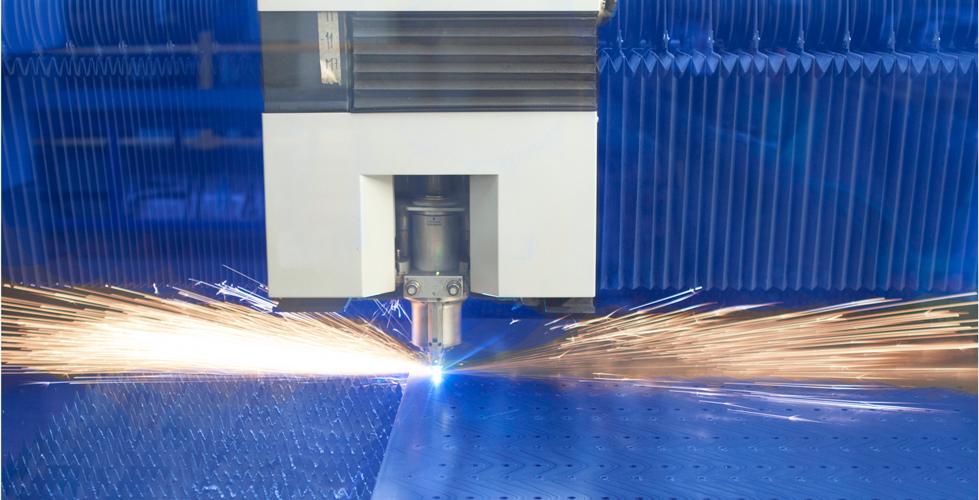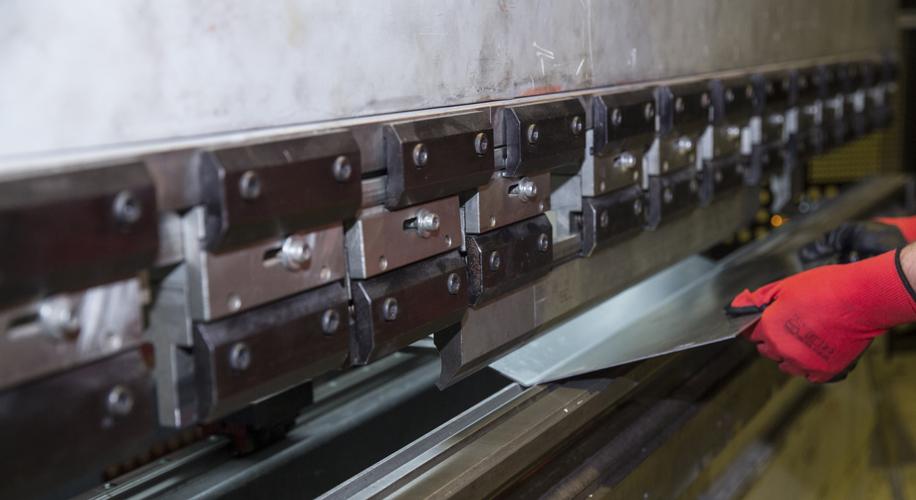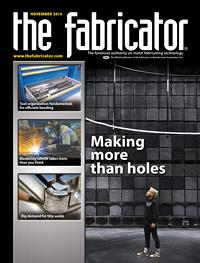Vice President, Engineering,
- FMA
- The Fabricator
- FABTECH
- Canadian Metalworking
Categories
- Additive Manufacturing
- Aluminum Welding
- Arc Welding
- Assembly and Joining
- Automation and Robotics
- Bending and Forming
- Consumables
- Cutting and Weld Prep
- Electric Vehicles
- En Español
- Finishing
- Hydroforming
- Laser Cutting
- Laser Welding
- Machining
- Manufacturing Software
- Materials Handling
- Metals/Materials
- Oxyfuel Cutting
- Plasma Cutting
- Power Tools
- Punching and Other Holemaking
- Roll Forming
- Safety
- Sawing
- Shearing
- Shop Management
- Testing and Measuring
- Tube and Pipe Fabrication
- Tube and Pipe Production
- Waterjet Cutting
Industry Directory
Webcasts
Podcasts
FAB 40
Advertise
Subscribe
Account Login
Search
Maximizing operational performance with automation
Software is the answer to getting the most from shop floor operations
- By John Reynolds
- November 7, 2014
- Article
- Manufacturing Software
From the lobby receptionist to the engineer, each individual and every department makes an impact on a company’s bottom line. But with its tremendous arsenal of machinery, inventory, supplies, and manpower, nowhere is that correlation more direct than on the manufacturing shop floor. Depending on its level of automation and efficiency, a fabrication operation can either be a competitive advantage or a money pit.
Company owners and managers are very aware of wasted costs associated with machine downtime, excessive scrap, and redundant job functions. They also know that poorly fabricated parts result in rework at best and lost contracts at worst.
In a strange paradox, these wastes often can be linked to an attempt to be too frugal. When purchasing a new cutting machine, for example, metal fabricators might be able to justify spending a little more for state-of-the-art equipment that will result in long-term benefits, but at the same time, they might not give the same consideration to the software needed to drive that same piece of machinery. Consequently, when a cutting machine’s features are not fully optimized, the fabricator experiences inefficient runs and slow cycle times.
Those few extra minutes for a cutting job, the extra consumables used up during that time, and a couple inches of excess scrap to complete a job might seem trivial, but when they are added up at the end of a year, the result is thousands of wasted dollars.
And that’s just waste that occurs when the machines are running. Idle machines represent a whole other level of waste that can result from an underperforming or underutilized software system. When the machine is not running, whether because of unscheduled downtime, an absent programmer or operator, inadequate inventory, or an upstream production bottleneck, it is not making money. Meanwhile, customers aren’t getting deliveries on time, and they may begin to look elsewhere to find a reliable source of metal fabricating services.
What could be even worse is if the machine tool isn’t running because it is damaged because of carelessness and poor-performing software. Sometimes when cutting heads are programmed to cut metal as quickly as possible, they are damaged when they collide with parts or loose material on the cutting table that protrudes on a plane higher than that of the material surface.
When the cutting sequence takes the head back into the vicinity of a previously cut part, the cutting head always runs the risk of colliding with a protruding part. When this occurs, the damage is likely fatal. A laser cutting head replacement can run between $10,000 and $30,000—not a trivial expense.
Given that these machine tools are very expensive and that production throughput is higher than it’s ever been for many fabricators, they realize that every minute of machine time is of considerable value to the company’s overall profitability. In a typical day, a fabricator only has a set number of hours to cover costs before it reaches a point where it starts turning a profit. This magic minute when a company begins making money does not come at the beginning of the day, but more than likely in its final hours. Any downtime shortens the workday, dramatically shrinking the window for a company to reach profitability.
More Hidden Costs
Maybe a fabricator is satisfied with its shop floor operations. Unfortunately, waste isn’t confined to the four walls of the shop. Front-office activities are a prime candidate for streamlining, and again the proper software and altered job processes can make a big difference.
Just look at a legacy quoting process reliant on guesswork. The sales representative grabs a part and takes some quick measurements. He then quickly looks at material rates, guesses at the time needed to cut and clean up the parts, and determines what can be charged to cut the parts based on his knowledge of the market. After the customer agrees to the quote, it sends a purchase order to the fabricator. A programmer then creates the geometry, adds cutting routes, and keeps fingers crossed that the job is a profitable one.
Obviously, this approach has many flaws. The idea of doubling the work, from a quote to an order, is illogical and slow. Consider that a shop wins 70 percent of its quoted jobs, yet has to redraw 100 percent of these parts to win those jobs. Assume a typical 20-part quote involves two individuals and takes an hour to quote and two hours to draw. This approach results in a lot of time and work that may not result in winning jobs. (Also, even if those jobs are won, no one is really sure if they will be profitable.)
Other areas that create a drain include unnecessary manual touch-points and redundancy associated with reworking (and often re-creating) CAD models because of the inability to import the files quickly into a downstream manufacturing process.
Additionally, many facilities have multiple types of fabrication machines that use specific software tailored to that particular machine; this approach may result in added software cost and programming personnel.
The Solution: Automation
Manufacturers are scrutinizing tools, processes, and practices to accelerate production while eliminating waste and unnecessary costs. Today software technologies are available to automate processes, integrate applications, and bridge interoperability gaps. Its future impact will be to bridge applications and automate manually intensive and complex processes. The results are sustained improvements to productivity and ultimately the bottom line.
Here are some examples of how modern software can transform traditional fabricating processes and bolster a company’s bottom line.
Quoting. With today’s sophisticated software, known variables are replacing guesstimates. The costing engine within nesting software examines all variables to determine material usage, labor-hours, and machine cutting time. Robust nesting software goes so far as to consider when a machine will slow its cutting process for certain maneuvers (such as laser and waterjet corner ramping for high-quality edges or plasma cutting holes for high-quality bolt holes), generating the most accurate forecast. The technology can help a fabricator to determine—in seconds—the actual costs to produce, resulting in accurate pricing and a profitable quote.
CAD Importing. Reworking CAD models because of a software package’s inability to import geometry not only adds time to a job, but also opens the door for introducing errors or altering design intent. Fortunately, software is available to pull models directly into downstream manufacturing applications, which removes the burden from programmers to push out data in special formats, such as IGES, DXF, and STEP. Robust CAD/CAM nesting software reads native CAD files; recognizes material thickness; and arranges the part on a corresponding sheet, simulating NC code and initiating cutting.
Work Order Organization. Automated work order management maintains organization, reduces errors, minimizes paper use and storage, and provides a simplified task list for programmers or operators. Additionally, job status information—whether it’s completed, in process, or overdue—is provided quickly to users. Work orders may be grouped according to date, material type, or customer.
Perhaps the biggest impact of modern software systems stems from the ability to mix orders. This provides nesting greater latitude in placing parts, saving cutting time while maximizing material yield as sheets are not limited to parts for one specific job. When this type of nesting capability is introduced to a job shop, scrap rate reduction of 5 percent to 20 percent is not uncommon.
Automatic Nesting. This application automatically determines the best strategy to optimize part cutting. Advanced software algorithms generate and examine multiple part orientation scenarios to determine how best to nest parts for maximum yield and minimal cut time, while making programming relatively simple. Still, it is important that the program allows user intervention as needed.
Nesting for Cutting. Any shop with multiple fabrication machines (or a desire to add machines in the future) might want to consider a single nesting software capable of driving all fabrication machines. Such a scenario allows a single programmer to work across all equipment.
Sophisticated software also can anticipate and avoid issues associated with cutting head crashes without compromising speed. These software programs have features such as intelligent sequencing of cutting paths and avoidance of scrap or other potential threat areas on a nest.
Shop Floor Guidance. As discussed earlier, the ability to combine jobs saves a significant amount of time. However, the inherent risk of mixing work orders creates a potential for confusion when unloading and sorting parts into the jobs to which they belong. Software can provide the needed guidance through a color-coded job display—with parts colored to corresponding job orders—on the machine’s controller. At the same time, the operator is alerted to any parts that may have cut quality issues. Poor-quality parts are rejected and automatically rescheduled for future cutting.
Bending. Sometimes no matter how it might look as a model, a part might be unmanufacturable, the result of a machine’s physical limitation, a lack of proper tooling, or a design flaw in the model. In the case of a press brake, the equipment may be unable to accommodate a flange because it is larger than the brake’s operational window.
A software bending program will unfold the part for flat nesting and consider all possible folding solutions. This allows bending issues to be immediately known. If the model is valid, the operator then can choose the desired bend sequence. Additionally, a report is created with instructions and bending details.
Remnant Handling. Where there is cutting, there are remnants, and each piece of material that ends up in the scrap bin is wasted money. Software can catalog and recall remnants best suited for a pending job, ensuring a more complete yield. The challenge lies in locating and accessing the remnant when it is needed.
Transaction Management. From updating inventory to creating work orders and communicating between the shop floor and management, transaction management software creates a lean manufacturing operation. The software bridges nesting and management software, such as material resource planning (MRP) systems. Because MRP software usually resides on large, centralized servers or mainframes and nesting software is normally installed on workstations, transaction management software manages their interaction.
Organizational Coordination. MRP software manages virtually all business and manufacturing processes. Capabilities generally include tracking work from costing/quoting through the ordering process, scheduling work on the shop floor, purchasing raw materials and other production items, and ultimately invoicing the customer. A modular MRP architecture allows selection of needed capabilities and the ability to grow the system along with the business.
Questions to Ponder
Just as all job functions have an impact on the bottom line, so too does each piece of equipment and every step in the manufacturing process. The good news is that now software allows fabricators to squeeze every bit of productivity out of these machines—and those who operate them—by maximizing advanced cutting features and automating related processes.
The not-so-good news is that manufacturers are not enjoying the benefits of modern software.
If the shop floor is to truly have a positive, significant, and lasting impact on profitability, more focus needs to be given to any software selection or upgrade.
These questions should be considered when researching manufacturing software:
- Is the software package proven to accelerate production cycles, optimize advanced machine functions, eliminate waste, and be responsive to changing shop floor scheduling needs?
- Is the software flexible enough to drive multiple machines, integrate business and manufacturing systems, and be scalable to adapt to changing requirements?
- Is the software easy to learn and use and well-supported?
About the Author
John Reynolds
1445 Kemper Meadow Drive
Cincinnati, OH 45240
513-674-0005
Related Companies
subscribe now

The Fabricator is North America's leading magazine for the metal forming and fabricating industry. The magazine delivers the news, technical articles, and case histories that enable fabricators to do their jobs more efficiently. The Fabricator has served the industry since 1970.
start your free subscription- Stay connected from anywhere

Easily access valuable industry resources now with full access to the digital edition of The Fabricator.

Easily access valuable industry resources now with full access to the digital edition of The Welder.

Easily access valuable industry resources now with full access to the digital edition of The Tube and Pipe Journal.
- Podcasting
- Podcast:
- The Fabricator Podcast
- Published:
- 04/16/2024
- Running Time:
- 63:29
In this episode of The Fabricator Podcast, Caleb Chamberlain, co-founder and CEO of OSH Cut, discusses his company’s...
- Trending Articles
Capturing, recording equipment inspection data for FMEA

Tips for creating sheet metal tubes with perforations

Are two heads better than one in fiber laser cutting?

Supporting the metal fabricating industry through FMA

Hypertherm Associates implements Rapyuta Robotics AMRs in warehouse

- Industry Events
16th Annual Safety Conference
- April 30 - May 1, 2024
- Elgin,
Pipe and Tube Conference
- May 21 - 22, 2024
- Omaha, NE
World-Class Roll Forming Workshop
- June 5 - 6, 2024
- Louisville, KY
Advanced Laser Application Workshop
- June 25 - 27, 2024
- Novi, MI





























